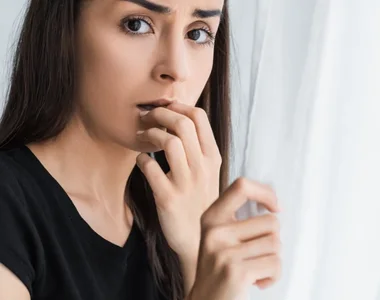
As a doctor, my life revolves around caring for my patients, helping them to be healthy, educating them about illnesses, and addressing signs of health concerns that need to be addressed. However, a few weeks ago, I realized that I had been ignoring the signs of my major health problem.
To my surprise, I was diagnosed with scalp cancer. The diagnosis of basal cell cancer and the fact that I ignored it for so long really made me stop to reflect on my health habits and some common misconceptions about skin cancer.
For over a year, I thought I had an irregular lump of skin behind my left ear. She was covered in hair, so it was easy to ignore. I thought it was eczema, which I have had for many years. I finally went to the dermatologist, much later than I should have given my medical history, and had a biopsy. Basal cell cancer. Another one was found on my neck soon after.
I was confused. I thought I had protected myself from sun exposure very carefully. I spend most hours inside the hospital and put on sunscreen every day. I don't have time to sunbathe, and on those rare occasions when I'm in the sun for a long time, I try to cover up.
As it turned out, my skin cancer had probably been developing for decades, the result of genetics and exposure to the sun many years ago. The damage from the sun's UV rays is extensive, increasing the risk of cancer over time. Just five blistering sunburns in 15- to 20-year-olds can increase the risk of melanoma by 80% and two other skin cancers, squamous cell carcinoma and basal cell carcinoma, by 68%, according to a study published in Cancer Epidemiology Biomarkers & Prevention. So I was probably suffering the consequences of my early years at the beach.
My mother also had multiple skin cancers, so my risk of getting one was significantly higher. When there is a family history of skin cancer, the risk of early-onset basal cell cancer is twice as high, according to the journal Cancer Epidemiology, the risk of squamous cell cancer increases fourfold, according to the journal Dermatologic Surgery, and the risk of melanoma is increased by 74%, as reported in the Journal of the American Academy of Dermatology.
However, I found it so strange that my skin cancer appeared on my scalp, under my hair. Wouldn't areas exposed to the sun like the nose, forehead or chin be more sensitive?
Me një hulumtim të vogël, zbulova se 13% e kancereve të lëkurës përfshijnë lëkurën e kokës, sipas një artikulli në Journal of the German Society of Dermatology. Kanceri i lëkurës mund të shfaqet në të gjitha llojet e njollave të pazakonta - qepallat, pëllëmbët e duarve dhe shputat e këmbëve.
Kanceri i lëkurës gjithashtu mund të ndodhë në të gjitha llojet e lëkurës. Sëmundjet malinje janë shumë më të zakonshme të lëkurat e bardha, por kanceri i lëkurës me pigmentim më të errët shpesh kapet më vonë, me norma më të larta vdekshmërie. Të gjithë janë në rrezik.
Tani më shumë se kurrë, mbrojtja nga dielli është kaq e rëndësishme sepse rreziku i zhvillimit të kancerit të lëkurës po përshkallëzohet me një shkallë alarmante. Është vlerësuar nga Akademia Amerikane e Dermatologjisë se një në pesë amerikanë do të kenë kancer të lëkurës gjatë jetës së tyre dhe shkalla e kancerit të lëkurës jo melanomë është rritur me 33% në të gjithë globin që nga viti 2007, sipas JCO Global Oncology.
Shumë ekspertë përmendin si faktorë rreziku ndryshimin e klimës, ngrohjen globale dhe rritjen e ekspozimit ndaj rrezeve të dëmshme UV. Pavarësisht këtij rreziku në rritje, përpjekjet tona në parandalimin e kancerit të lëkurës dhe zbulimin e hershëm janë të pamjaftueshme, ku shumë njerëz nuk arrijnë të bëjnë ekzaminime të rregullta të lëkurës.
Varet nga secili prej nesh që të mbrohet nga dielli sa më herët dhe të mësojë se kur duhet të kërkojë kujdes mjekësor për ndryshime të pazakonta në lëkurë. Parregullsitë si ndryshimet në ngjyrë, skajet e parregullt të nishaneve dhe njollave, plagët e lëkurës që nuk shërohen nuk duhet të injorohen kurrë. Një ekzaminim duhet të bëhet çdo vit për të monitoruar ndryshimet e pazakonta të lëkurës, ose nëse jeni në rrezik më të lartë për zhvillimin e kancerit të lëkurës.
Këtë verë, mbroni veten. Vendosni krem kundër diellit, mbani një kapelë dhe qëndroni në hije sa herë që të jetë e mundur. Dhe ajo pjesë e veçantë e lëkurës që keni injoruar? Mos e shtyni më kontrollimin. Mësova se çdokush mund të sëmuret nga kanceri i lëkurës dhe ai mund të shfaqet aty ku nuk e prisni. Sa më herët ta kapni, aq më të larta janë gjasat për të shpëtuar, ndaj shkoni te mjeku.
- written for CNN by Susannah Hill, pediatric respiratory surgeon and vice chair of the Department of Otolaryngology Head and Neck Surgery at Columbia University Medical Center.







